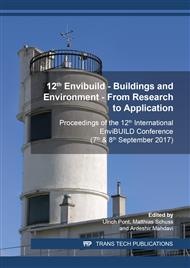[1]
Pérez, G., Coma, J., Martorell, I., Cabeza, L. F. Vertical Greenery Systems (VGS) for energy saving in buildings: A review. Renewable and Sustainable Energy Reviews 39, 139-165, 2014. http://dx.doi.org/10.1016/j.rser.2014.07.055.
DOI: 10.1016/j.rser.2014.07.055
Google Scholar
[2]
Evelia S., Blanco, I., Campiotti, C.A., Bibbiani, C., Fantozzi, F., Vox, G. Green control of microclimate in buildings. Agriculture and Agricultural Science Procedia 8, 576 – 582, 2016. http://dx.doi.org/10.1016/j.aaspro.2016.02.078.
DOI: 10.1016/j.aaspro.2016.02.078
Google Scholar
[3]
Cameron, R. W. F., Taylor, J. E., Emmett, M. R. What's cool' in the world of green façades, How plant choice influences the cooling properties of green walls. Building and Environment 73, 198-207, 2014. http://dx.doi.org/10.1016/j.buildenv.2013.12.005.
DOI: 10.1016/j.buildenv.2013.12.005
Google Scholar
[4]
Norton, B. A., Coutts, A. M., Livesley, S. J., Harris, R. J., Hunter, A. M., Williams, N. S. G. Planning for cooler cities: A framework to prioritise green infrastructure to mitigate high temperatures in urban landscapes. Landscape and Urban Planning 134, 127-138, 2015. http://dx.doi.org/10.1016/j.landurbplan.2014.10.018.
DOI: 10.1016/j.landurbplan.2014.10.018
Google Scholar
[5]
Lerma, C.; Mas, Á.; Gil, E.; Vercher, J.; Peñalver, M.J. Pathology of Building Materials in Historic Buildings. Relationship Between Laboratory Testing and Infrared Thermography. Mater. Construcc. 64 [313], e009, 2014. http://dx.doi.org/10.3989/mc.2013.06612.
DOI: 10.3989/mc.2013.06612
Google Scholar
[6]
Ferdoush, S., Li, X. Wireless sensor network system design using raspberry Pi and Arduino for environmental monitoring applications. The 9th International Conference on Future Networks and Communications (FNC'2014)/The 11th International Conference on Mobile Systems and Pervasive Computing (MobiSPC'14), Ontario, Canada, August 17–20 vol. 34, p.103–110, 2014. http://dx.doi.org/10.1016/j.procs.2014.07.059.
DOI: 10.1016/j.procs.2014.07.059
Google Scholar
[7]
Hut, R. New Observational Tools and Data Sources for Hydrology: Hydrological Data Unlocked by Tinkering (Master thesis) Delft University of Technology, Amsterdam, Netherlands, (2013).
Google Scholar
[8]
Ali, A., Zanzinger, Z., Debose, D., Stephens, B. Open Source Building Science Sensors (OSBSS): A low-cost Arduino-based platform for long-term indoor environmental data collection. Building and Environment 100, 114-126, 2016. http://dx.doi.org/10.1016/j.buildenv.2016.02.010.
DOI: 10.1016/j.buildenv.2016.02.010
Google Scholar
[9]
Mccarter W, Vennesland O. Sensor systems for use in reinforced concrete structures. Constrtion and Building Materials 18(6), 351–8, 2004. http://dx.doi.org/10.1016/j.conbuildmat.2004.03.008.
DOI: 10.1016/j.conbuildmat.2004.03.008
Google Scholar
[10]
Ytong. Guía técnica. El hormigón celular YTONG, material de construcción. http://www.ytong.es/es/docs/GuiaTecnica_Ytong_2014.pdf. Visited on 2017-02-17.
DOI: 10.1002/dama.201400631
Google Scholar
[11]
AENOR. Specification for masonry units. Part 4: Autoclaved aerated concrete masonry units (UNE-EN 771-4) (2016).
DOI: 10.3403/02215057
Google Scholar
[12]
Vercher, J., Cubel, F., Lerma, C., Mas, Á., Gil, E. Contributions of traditional façades to the thermal comfort. Earthen Architecture: Past, Present and Future. 2015 Taylor & Francis Group. ISBN 978-1-138-02711-4.
DOI: 10.1201/b17392-66
Google Scholar
[13]
Ansys. 2013. Ansys 15.0 Help Manual. Ansys Inc. Ansys Academic Research V15.0. USA.
DOI: 10.33737/gpps19-bj-191
Google Scholar


